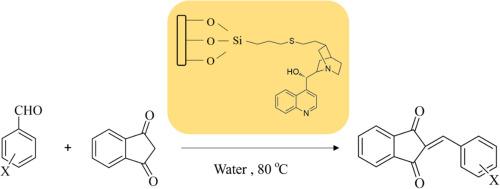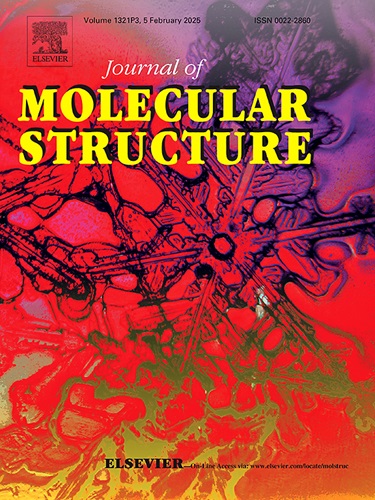将金鸡纳树碱接枝到稻壳纳米二氧化硅上及其在合成 2-芳基亚茚-1,3-二酮和 2-芳基亚茚-5,5-二甲基-1,3-环己二酮中的潜在应用
IF 4
2区 化学
Q2 CHEMISTRY, PHYSICAL
引用次数: 0
摘要
本研究利用稻壳二氧化硅锚定金鸡纳树纳米复合材料作为水介质中的异相催化剂,报道了芳香醛与茚满-1,3-二酮和二咪酮发生克诺文那格尔缩合反应的环保绿色程序。无需额外的表面活性剂,稻壳就可用作制造纳米二氧化硅的原料。通过接枝 3-巯丙基)三甲氧基硅烷,稻壳纳米二氧化硅被改性。接着,使用偶氮二异丁腈引发剂引发 SH 基团与 Cinchonine 烯功能的硫醇-烯自由基相互作用。利用傅立叶变换红外光谱、场发射扫描电子显微镜和能量色散 X 射线光谱对纳米 SiO2-S-Cinchonine 的形貌和结构进行了表征。研究了该纳米复合材料在 80 °C 水介质中通过 Knoevenagel 缩合反应合成 2-芳基亚茚-1,3-二酮和 2-芳基亚茚-5,5-二甲基-1,3-环己二酮的催化活性。这种方法的优点是方法简单、产率高、易于操作和使用绿色溶剂。本文章由计算机程序翻译,如有差异,请以英文原文为准。

Grafting of cinchonine onto rice husk nanosilica and its potential application in the synthesis of 2‐arylideneindan‐1,3‐diones and 2‐arylidene-5,5-dimethyl-1,3-cyclohexanedione
In this study, an eco-friendly and green procedure for Knoevenagel condensation reaction of aromatic aldehydes with indan-1,3-dione and dimedone was reported utilizing a rice husk silica‐anchored cinchonine nanocomposite as a heterogeneous catalyst in aqueous media. Without the need for an additional surfactant, rice husk was utilized as a raw material to create nanosilica. Through the grafting of 3-mercaptopropyl) trimethoxysilane, the rice husk nanosilica was modified. Next, azobisisobutylonitrile initiator was used to trigger the thiol-ene free radical interaction of the SH groups with the Cinchonine's alkene function. The morphology and structure of the nano SiO2-S-cinchonine were characterized using fourier transform infrared spectra, field emission scanning electron microscope, and energy-dispersive X-ray spectroscopy. The catalytic activity of the nanocomposite was investigated in the synthesis of 2-arylideneindan-1,3-diones and 2-arylidene-5,5-dimethyl-1,3-cyclohexanedione through an aqueous medium at 80 °C by the Knoevenagel condensation reaction. The advantages of this method are simple methodology, high yields, easy work-up, and green solvent.
求助全文
通过发布文献求助,成功后即可免费获取论文全文。
去求助
来源期刊

Journal of Molecular Structure
化学-物理化学
CiteScore
7.10
自引率
15.80%
发文量
2384
审稿时长
45 days
期刊介绍:
The Journal of Molecular Structure is dedicated to the publication of full-length articles and review papers, providing important new structural information on all types of chemical species including:
• Stable and unstable molecules in all types of environments (vapour, molecular beam, liquid, solution, liquid crystal, solid state, matrix-isolated, surface-absorbed etc.)
• Chemical intermediates
• Molecules in excited states
• Biological molecules
• Polymers.
The methods used may include any combination of spectroscopic and non-spectroscopic techniques, for example:
• Infrared spectroscopy (mid, far, near)
• Raman spectroscopy and non-linear Raman methods (CARS, etc.)
• Electronic absorption spectroscopy
• Optical rotatory dispersion and circular dichroism
• Fluorescence and phosphorescence techniques
• Electron spectroscopies (PES, XPS), EXAFS, etc.
• Microwave spectroscopy
• Electron diffraction
• NMR and ESR spectroscopies
• Mössbauer spectroscopy
• X-ray crystallography
• Charge Density Analyses
• Computational Studies (supplementing experimental methods)
We encourage publications combining theoretical and experimental approaches. The structural insights gained by the studies should be correlated with the properties, activity and/ or reactivity of the molecule under investigation and the relevance of this molecule and its implications should be discussed.
 求助内容:
求助内容: 应助结果提醒方式:
应助结果提醒方式:


